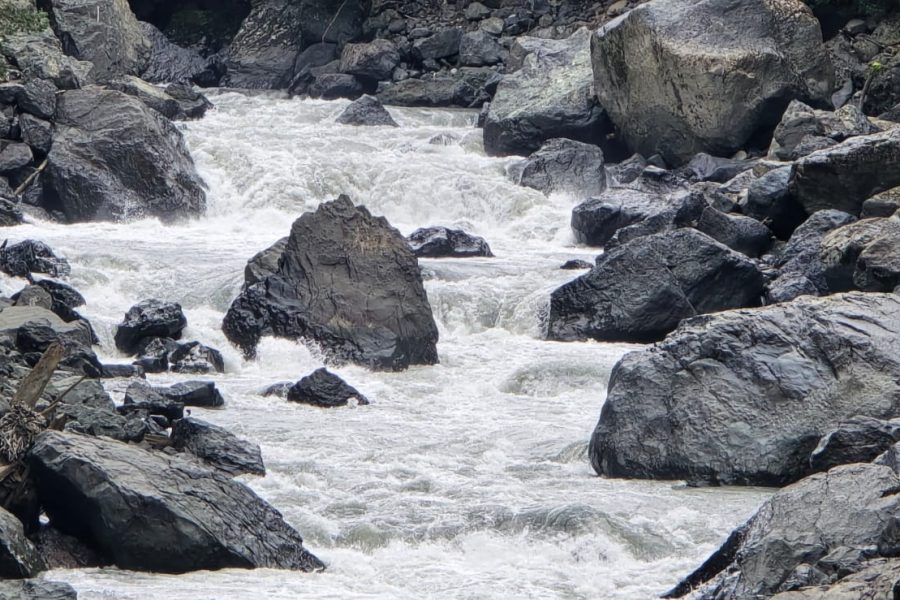The Amtkeli River: The Karst River of Lake Amtkeli
The Amtkeli River (მდინარე ამტყელი) is a unique and fascinating river in the Gulripshi District of Abkhazia, Georgia, primarily known for forming the stunning Lake Amtkeli. This is a classic karst river, meaning its flow is heavily influenced by the soluble limestone rock of the region, causing it to appear and disappear underground. The river and the lake it forms are the result of a massive natural event—a landslide from a nearby mountain in 1891 that dammed the river valley, creating the second-largest lake in Abkhazia.
The river’s course is one of nature’s marvels. It emerges from a large cave, flows for a short distance, and then empties into the deep, cold waters of Lake Amtkeli. At the other end of the lake, the water finds its way out and the Amtkeli river continues, only to vanish underground again into a karst sinkhole. It is believed to re-emerge further downstream to join the Kodori River. This subterranean journey makes the Amtkeli a river of mystery and a prime example of the dramatic geological processes at work in the Caucasus mountains.
ℹ️ General Information
- Name of River: Amtkeli River (მდინარე ამტყელი)
- Location: Gulripshi District, Abkhazia, Georgia.
- Length: The visible surface sections are short; the total length including its underground course is approximately 30-35 km.
- Basin Size: Not precisely documented.
- Source (Origin): Emerges from a karst cave system in the Caucasus foothills.
- Mouth (Where it flows): Disappears into a sinkhole; eventually joins the Kodori River.
- Key Feature: Forms Lake Amtkeli.
📍 Geography & Course
The geography of the Amtkeli is defined by its karst nature. The river appears suddenly from the ground, feeds Lake Amtkeli, and then disappears just as abruptly. Lake Amtkeli itself has a highly variable water level, rising by as much as 40 meters during the spring snowmelt and shrinking during the dry summer as the outflow into the sinkhole exceeds the inflow. The lake is surrounded by steep, forest-covered mountains, and its water is a beautiful turquoise color.
🌿 Nature & Ecology
The ecosystem around the Amtkeli is rich and diverse. The forests are part of the Colchic rainforest system, with abundant beech, fir, and boxwood. The lake is home to several fish species, including trout and chub, which have adapted to its unique conditions. The surrounding area is a habitat for brown bears, roe deer, and a variety of birdlife. The river and lake are central to a vibrant, isolated ecosystem.
🏛️ History & Culture
The Amtkeli valley lies within the historical region of Abkhazia, a territory with an ancient and rich history. While the river’s most famous feature, the lake, is geologically very young (formed in 1891), the surrounding valleys and mountains have been inhabited for centuries. The nearby Kodori Gorge is a historically significant region. The dramatic formation of the lake is a key part of the area’s modern folklore and natural history.
🚣 Activities & Tourism
Lake Amtkeli and its river are a popular destination for nature tourism and adventure:
- Boating and Fishing: The lake is an excellent spot for fishing and exploring by boat.
- Hiking: There are numerous trails in the surrounding mountains, offering spectacular views of the lake and the Caucasus.
- Caving: The region is rich in karst caves, attracting experienced cavers.
- Photography: The combination of the turquoise lake, lush forests, and towering mountains makes it a photographer’s paradise.
🛤️ Accessibility
Access to Lake Amtkeli can be challenging. It is reached via a mountain road from Gulripshi, which may require a 4×4 vehicle, especially after heavy rains. The best time to visit is during the summer and early autumn when the weather is stable and the road is in its best condition. The area is remote, and visitors should be well-prepared for a trip into a wilderness area.



Leave a review